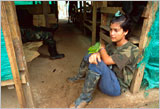|
Bloodshed
at The Palace of Justice
The M-19 insurgent group, though short-lived, was very significant.
Once a middle-class led leftist force that valued nationalism and
the teachings of independence hero Simón Bolivar above Lenin,
Marx, and Mao, the M-19 established a nationwide military presence,
drawing political admiration and even support from a broad cross-section
of society. Repeated attacks on delivery trucks whose cargoes were
then distributed to the poor gave M-19 insurgents an air of modern-day
Robin Hoods.
But in November 1985, the insurgent group invaded and occupied the
Palace of Justice, which houses Colombia’s Supreme Court, with
the plan to put the civil government on trial for its failure to
remedy social inequity. But the armed forces immediately mobilized,
and seized the building back in 48 hours of brutal urban warfare.
After it was over, the nation’s top judges lay dead, and most
of the M-19 leadership had been killed or disappeared. The group’s
survivors de-mobilized. The Palace of Justice tragedy was an historical
turning point: not only did it produce front-page headlines all
over the world, it brought the "invisible" dirty war from
the hinterlands to the capital.
The Massacre of the Unión Patriótica
In 1986, after two decades of fighting, the government of Belisario
Betancur negotiated a truce with the FARC. The guerrillas then created
a legal political party, the Unión Patriótica (Patriotic
Union), which met with some success in local elections. At the same
time, a campaign of terror and assassination was unleashed against
the UP, effectively decimating the party by the early 1990s. The
political arena increasingly resembled a minefield. The FARC reverted
to war.
U.S. AID – ANOTHER SALVADOR OR ANOTHER VIETNAM?
Vietnam-era Huey helicopters clatter over the Tres Esquinas, or
"Three Corners", military base deep in the jungles of
southern Caquetá province. U.S. Special Forces advisers spin
around the complex in imposing Humvee all-terrain trucks. The Colombian
army’s elite, counterdrug battalions, trained by the U.S. advisers,
parade and practice incessantly, ready for the next sortie into
guerrilla country.
Tres Esquinas is the forward command center for Colombia’s
U.S.-backed war effort in the south, known as "Plan Colombia."
Bankrolled with more than $1 billion in mostly military aid from
Washington in fiscal years 2000 and 2001, it ostensibly targets
spiraling cocaine and heroin production.
|

San
Vicente del Caguán, Colombia. A guerrilla fighter at the
camp barracks.
|
